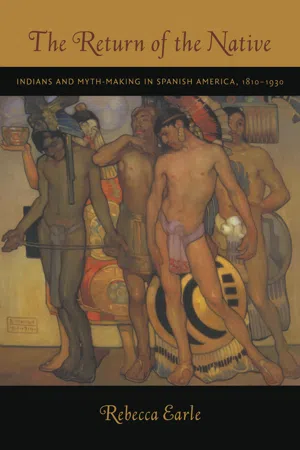
The Return of the Native
Indians and Myth-Making in Spanish America, 1810–1930
- English
- PDF
- Available on iOS & Android
About this book
Starting with the anti-Spanish wars of independence in the early nineteenth century, Earle charts the changing importance elite nationalists ascribed to the pre-Columbian past through an analysis of a wide range of sources, including historical writings, poems and novels, postage stamps, constitutions, and public sculpture. This eclectic archive illuminates the nationalist vision of creole elites throughout Spanish America, who in different ways sought to construct meaningful national myths and histories. Traces of these efforts are scattered across nineteenth-century culture; Earle maps the significance of those traces. She also underlines the similarities in the development of nineteenth-century elite nationalism across Spanish America. By offering a comparative study focused on Mexico, Guatemala, Colombia, Peru, Chile, and Ecuador, The Return of the Native illustrates both the common features of elite nation-building and some of the significant variations. The book ends with a consideration of the pro-indigenous indigenista movements that developed in various parts of Spanish America in the early twentieth century.
Frequently asked questions
- Essential is ideal for learners and professionals who enjoy exploring a wide range of subjects. Access the Essential Library with 800,000+ trusted titles and best-sellers across business, personal growth, and the humanities. Includes unlimited reading time and Standard Read Aloud voice.
- Complete: Perfect for advanced learners and researchers needing full, unrestricted access. Unlock 1.4M+ books across hundreds of subjects, including academic and specialized titles. The Complete Plan also includes advanced features like Premium Read Aloud and Research Assistant.
Please note we cannot support devices running on iOS 13 and Android 7 or earlier. Learn more about using the app.
Information
Table of contents
- Cover
- Contents
- Acknowledgments
- Introduction On “Indians”
- Chapter 1 Montezuma’s Revenge
- Chapter 2 Representing the Nation
- Chapter 3 “Padres de la Patria”: Nations and Ancestors
- Chapter 4 Patriotic History and the Pre-Columbian Past
- Chapter 5 Archaeology, Museums, and Heritage
- Chapter 6 Citizenship and Civilization: The “Indian Problem”
- Chapter 7 Indigenismo: The Return of the Native?
- Epilogue
- Appendix Abolishing the Indian?
- A Note on Sources
- Notes
- Bibliography
- Index